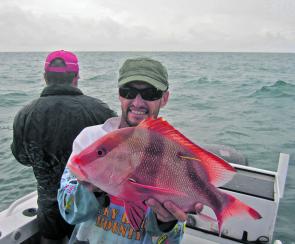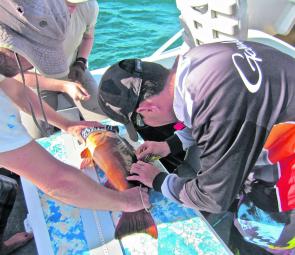The common July westerlies are already here and the crisp mornings are bringing in numbers of lesser mackerels inside the wind curtain.
The fish usually go off the chew when the westerly winds roll in but the lay of the Yeppoon coastline gives us an area out to about 10km before the wind hits the water. We find that this and the area immediately behind the Keppels are sheltered from the wind and the mackerel in this zone stay on the bite when others are put off. The majority of our better spotted mackerel and Queensland school mackerel spots are very close to the mainland.
Whenever the wind drops and the morning is cold and foggy there will be mackerel about. From Quartz Rock off Keppel Sands through the Emu Park Islands and Rita Mada, Ironpot, Rosslyn Bay Harbour, Stevenson’s Rocks, Bluff Rocks and Corio Heads all hold mackerel especially with a rising tide.
The two main methods of capture are floating pilchards and casting chrome slugs. The first option is as easy as it sounds, set up a pilly on gang hooks then float it out in the current, and when the mackerel are a bit deeper just add a pea sinker above the hooks to take it down a little. Berley is the key to a decent catch when there are other boats around or the fish are quiet.
In between the other species we have had a show of very large grey or broad-barred mackerel. These guys grow upwards of 9kg and fight very well. In the past few years the average size of the greys that pass through our area has increased dramatically. Once upon a time they were not much bigger than legal with the odd fish reaching three or four kilos. Lately the size has nearly doubled and they are a very welcome by catch that are extremely good table fare if bled on capture and put straight on ice or an icy brine.
They can be taken on lures or baits although the better catches I have seen in recent years have all been scored on Flashas. They often feed near the bottom so it pays to let your chromie sink to the bottom or very close before a very fast retrieve.
Spanish are beginning to slow down again after a great season where the school sized fish stayed in the area much longer than usual. There are still plenty about at all the normal spots and over the deeper fern patches. We always have a floater out the back and when it gets taken out come the Taipans for a bit of fast jigging. Not a bad way to top off a catch of reefies.
The black jew have moved in large numbers with the last full moon and captures have been spread across a large portion of the jew holes. Double Heads has been firing and the Blowhole is the pick spot. This area can be accessed from the rocks making for great land-based jew action. Other standouts are Cape Capricorn jew hole, Quartz Rock from Keppel Sands, Wedge, Pelican and Divide out from Emu Park, Corio Heads and Cape Manifold.
The biggest bream in the area come from the mouth of the Fitzroy River Delta and down into The Narrows; the passage between Curtis Island and the mainland. The anglers targeting them are gettoing fish as big as two kilo and get busted up on standard tackle with monotonous regularity.
They are more often than not hanging along the oyster rocks and mangrove edges where they smash any bait close enough. Berley works well and you can draw them closer to the boat if you keep a slow constant stream running with the tide. On the incoming tide they will comb the banks and surrounds of the rock patches in water so shallow their dorsal fins come out like salmon or tarpon.
Blue salmon are on the go right along the beaches and into nearly all the local systems. They congregate in the creek mouths feeding on yabbies, prawns and small herrings. Down the bottom of the river they seem to turn up at the just covered rock bars over the highest part of the tide and disappear as the level drops. A live prawn under a float is one method they can’t resist and king salmon are just as likely to grab it if the blues aren’t on show. Out in the surf and beach gutters they can just as easily take a pilchard on a gang set as if you were chasing tailor.
The better-sized king salmon have moved further up the estuaries and last trip to Coorooman Creek we saw plenty of them in the muddiest parts of the creek. They move along the banks with the rising tide smashing small critters as the tide exposes them in the shallows. We usually flick unweighted prawns or small poddy mullet up into the shallows ahead of the salmon as they search the muddy banks.
Last month The Keppel Bay Sportfishing Club got together with researchers from James Cook University who had secured special permits for a limited amount of catch and release in marine protected areas of The Keppels. When the offer was made, the local boys gladly helped out.
A researcher accompanied each club boat to ensure fishing was conducted according to strict standards. The primary species were red emperor, stripeys and coral trout. Each fish was measured, tagged and a small piece of fin was clipped to determine its generic fingerprint before releasing the fish.
Up to 20 trout and a swag of other species were taken each day. Some of the fish had been tagged before and one red emperor was tagged the day before showing that tag and release doesn’t effect the fish when done properly. The survey is being done to determine the benefit of the green zones.
The findings suggest that the green zones are producing half of all the juvenile recruitment within a 30km range of the closed areas. In effect providing a baby bonus to 72% of areas where recreational fishers can currently fish. Researchers believe that these results provide compelling evidence that adequately protected reserve networks can make a significant contribution to the replenishment of populations on both reserve and fished reefs at a scale that benefits thousands of anglers who flock the Keppel Islands each year.
Reads: 5725
A lovely little red caught and tagged the day before the James Cook University researchers caught it.

Nathan with a big coral trout caught while tagging in the green zones.

The guys from Keppel Bay Sportfishing Club tagging another trout ready for release.




